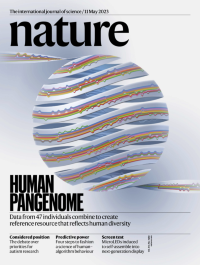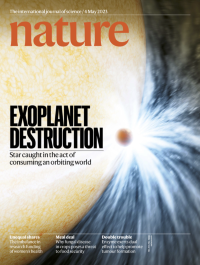Volume 617
-
No. 7962 25 May 2023
Bending the rulesFlexible solar cells have great potential for photovoltaics integrated into buildings or in wearable electronics. But silicon-based solar cells tend to be too brittle to offer sufficient flexibility. In this week’s issue, Wenzhu Liu and colleagues present a way to make foldable silicon wafers that can be used in flexible solar cells. The secret to success was to blunt the edges of the silicon wafers, thereby stopping them from undergoing brittle fracturing. As a result, the researchers were able to make 15-centimetre solar cells with a bending angle of more than 360°. The team suggests that this process could be used in the large-scale manufacture of flexible cells that could have a wide range of uses, such as powering street lights as shown in the artist’s impression on the cover.
Spotlight
-
No. 7961 18 May 2023
Raging bullsThe cover shows an artist’s impression of two male mammoths fighting. During episodes of musth, adult male elephants undergo periods of elevated testosterone levels associated with aggression and competition for mating. In this week’s issue, Michael Cherney and his colleagues show that male woolly mammoths (Mammuthus primigenius) experienced similar episodes of musth. The researchers focused on tusks, which provide a record of growth in their layers of dentin. Using liquid chromatography with tandem mass spectrometry, the team was able to reconstruct hormone records using dentin extracted from modern elephant and prehistoric mammoth tusks. The results revealed similar testosterone fluctuations in the male mammoth as those associated with musth in the record for the male African elephant.
-
No. 7960 11 May 2023
Human pangenomeThe human reference genome has been the backbone of human genomics since the release of the draft sequence in 2001. But it has its limitations: one genome cannot hope to capture the diversity of the human species. In this week’s issue, the Human Pangenome Reference Consortium presents the first draft human pangenome, which combines genetic material from 47 genetically diverse individuals to provide a more complete picture of the human genome. Two additional papers use this new resource to study regions of the genome that include repetitive DNA: one looking at segmental duplications, the other at the short arms of acrocentric chromosomes. These results come from an early stage in the pangenome project, which ultimately aims to capture the genetic diversity of at least 350 individuals. The cover shows the pangenome wrapping a globe and uses a sequence tube map rendering of a pangenome graph relating ten haplotypes within the highly variable HLA-A locus on chromosome 6 created by Adam Novak at the University of California, Santa Cruz.
-
No. 7959 4 May 2023
Exoplanet destructionAs stars evolve, they expand and so will engulf planets in close orbit around them. This planetary catastrophe is expected to generate powerful luminous ejections of mass from the star, although this has not been observed directly. In this week’s issue, Kishalay De and his colleagues present observations of a short-lived optical outburst in the Galactic disk accompanied by bright, long-lived infrared emission. The combination of low optical luminosity and radiated energy suggests that the source of the outburst was the engulfment of a planet by its Sun-like star — an event that awaits Earth and the other planets of the inner Solar System in about 5 billion years, and that is captured in the artist’s impression on the cover.




